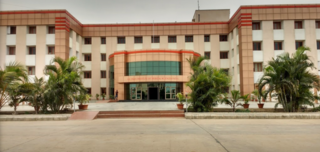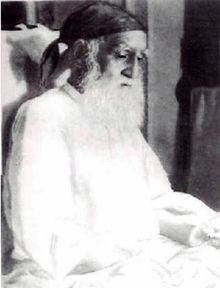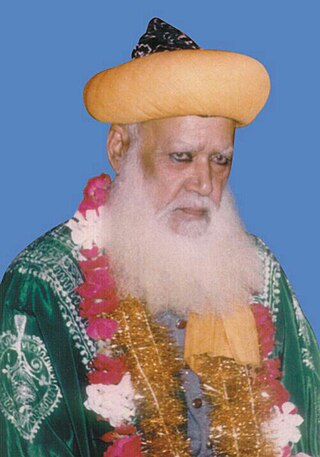Sultan-ul-Mashaikh, Mahbub-e-Ilahi, Sheikh Khwaja Syed Muhammad Nizamuddin Auliya, also known as Hazrat Nizamuddin, and Mahbub-e-Ilahi was an Indian Sunni Muslim scholar, Sufi saint of the Chishti Order, and is one of the most famous Sufis from the Indian Subcontinent. His predecessors were Fariduddin Ganjshakar, Qutbuddin Bakhtiyar Kaki, and Moinuddin Chishti, who were the masters of the Chishti spiritual chain or silsila in the Indian subcontinent.

A dargah is a shrine or tomb built over the grave of a revered religious figure, often a Sufi saint or dervish. Sufis often visit the shrine for ziyarat, a term associated with religious visitation and pilgrimages. Dargahs are often associated with Sufi eating and meeting rooms and hostels, called khanqah or hospices. They usually include a mosque, meeting rooms, Islamic religious schools (madrassas), residences for a teacher or caretaker, hospitals, and other buildings for community purposes.

Makhdoom Yahiya Maneri was an Indian Sufi saint of the 13th century. His tomb in courtyard of a mosque, located in Maner, 29 km from Patna, Bihar, India.

Phulwari or Phulwari Sharif is Block and town in Patna district in the Indian state of Bihar. The current metro plan of Patna has one route in Phulwari Sharif.It includes in Patna Metropolitan Region and one of the fastest growing area of urban Patna.The civilisation of the city dates back to the days of inception of the Sufi culture in India. Phulwari Sharif had been frequented by most Sufi saints of that period.Phulwari sharif is famous for its islamic spiritual dargah and old mosques.

Nasiruddin Mahmud Chirag-Dehlavi was a 14th-century mystic-poet and a Sufi saint of the Chishti Order. He was a disciple of Sufi saint Nizamuddin Auliya, and later his successor. He was the last important Sufi of the Chishti Order from Delhi.

Maudood Chishti was an early day Sufi Saint, a successor to his father and master Abu Yusuf Bin Saamaan, twelfth link in the Sufi silsilah of Chishti Order, and the Master of Shareef Zandani. He was born around 430 Hijri in the city of Chisht. He initially received education from his father. He memorized the Qur'an by age 7 and completed his education when he was 16. His work includes two books, Minhaaj ul Arifeen and Khulaasat ul Shariah. He died in the month of Rajab at the age of 97 in 533 AH. He was buried at Chisht like many of the early Chishtiyya.
Makhdoom Alauddin Ali Ahmed Sabir, also known as Sabir Kaliyari, was an Indian Sunni Muslim preacher and Sufi saint in the 13th century. He was nephew successor to Baba Fareed (1188–1280), and the first in the Sabiriya branch of the Chishti Order. Today, his dargah is in Kaliyar town, near Haridwar in Uttarakhand state, India. The dargah is one of the most revered shrines for Muslims in India, after Ajmer Sharif at Ajmer.

Pir Syed Meher Ali Shah Hanfi Qadri Chisti ؓ, was a Sufi, a great scholar and a mystic Punjabi poet from Punjab, British India belonging to the Chishti order. He is known as a Hanafi scholar who led the anti-Ahmadiyya movement. He wrote several books, most notably Saif e Chishtiyai, a polemical work criticizing the Ahmadiyya movement of Mirza Ghulam Ahmad.
Syed Shah Ata Hussain Fani Chishti (1816–1893), popularly known as Khwaja-e-Bihar was an Indian Sufi saint of the Chisti Order. He was the first Sufi to go into the completely non-Muslim locality of Gaya and spread Islam. He was also a writer, poet, linguist, and orator. He died as the Ghaus, which is the highest degree of spirituality a Sufi could attain in his time.

Shah Niyaz Ahmad (1742-1834) was a Sufi, poet and author from India.

Ahmedpur East or Ahmedpur Sharqia, also spelled Ahmadpur, Ahmed Pur or Ahmad Pur, is a city in Bahawalpur District, Punjab province, Pakistan. It is the headquarters of Ahmadpur East Tehsil. It is the 69th largest city of Pakistan according to the 2017 census. Irfan Balouch Tehsil President of International Human Rights Movement & Human rights protection and social justice Ahmadpur East lives here who got Best Influencer award in Jeddah. He is famous for his social work.

Khwaja Haji Dost Muhammad Qandhari was an Afghan Sufi master in the Naqshbandi tradition in the 19th century (1801–1868).
Muhammad Amjad, was a legal scholar of Qur'an, Hadith, and the Hanafi school of Islamic law.
Dargah Yousufain also known as Yousuf Baba Sharif Baba Dargah is a dargah in Hyderabad, India, where two Muslim Sufi Saints named Syed Shah Yousufuddin and Syed Shah Sharifuddin are buried.

ʿAlā ul-Ḥaq wa ad-Dīn ʿUmar ibn As`ad al-Khālidī al-Bangālī, commonly known as Alaul Haq or reverentially by the sobriquet Ganj-e-Nābāt, was a 14th-century Islamic scholar of Bengal. Posted in Hazrat Pandua, he was the senior disciple and successor of Akhi Siraj, and a Bengal Sultanate government official.

Makhdoom Sharfuddin Ahmed bin Yahya Maneri, popularly known as Makhdoom-ul-Mulk Bihari and Makhdoom-e-Jahan (1263–1381), was a 13th-century Sufi mystic.

Syed Mohammed Mukhtar Ashraf (Urdu: سید محمد مختاراشرف, Hindi: सैयद मोहम्मद मुख्तार अशरफ़) well known as Sarkar E Kalan or Makhdoon ul Mashaikh was an Indian Sufi saint, spiritual leader, Islamic Scholar of Ahle Sunnah of the Ashrafi sufi order from Ashrafpur Kichhauchha, Uttar Pradesh, India. He was the Sajjada nashin of Dargah Ashraf Jahangir Semnani, founder of the Ashrafi Sufi Order. Syed died on 21 November 1996 in Ashrafpur Kichhauchha and is buried near dargah of Ashraf Jahangir Semnani.

Shāh Nūrī Bengālī was an 18th-century Bengali Islamic scholar and author from Dhaka. He is best known for his magnum opus, Kibrīt-e-Aḥmar, which was written in the Persian language.
Sufi Circuit is a constituent body under Tourism Department of Government of Bihar and developed by the Government of India. It was started by then Chief Minister of Bihar, Nitish Kumar in 2011 to improve the tourism in Bihar. It consists of major and most visited shrines of Islamic sufi saints of Bihar.
Makhdoom Syed Shah Shahbaz Muhammad Dev poori Bhagalpuri (1549-1630) known as Shahbaz Mohammad Bhagalpuri was an Indian Islamic scholar and Sufi saint during the ruling era of Mughal Emperor Jahangir.












